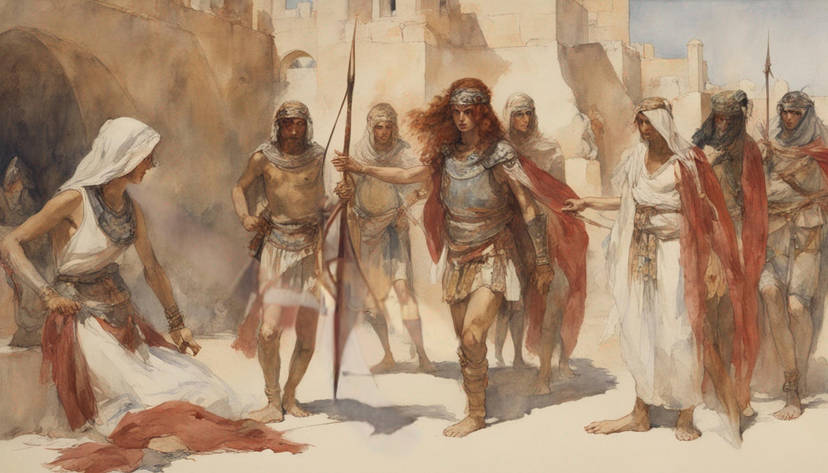After; Sir William Russell Flint Alma's Comrade Has been Ambushed
AI Generated
Intertwining elements of Sir William Russell Flint's style with a touch of Middle Eastern flair. Ilustrations that captures the pivotal moment from "Le Morte d'Arthur" with Alma, the Bedouin warrior woman at the forefront.
The illustrations feature a desert landscape as the backdrop, with the vastness of the sand stretching into the distance, conveying a sense of isolation and mystery. The sun would cast warm tones, illuminating the scene with golden hues.

After; Sir William Russell Flint
Alma's Asks for information, Her troops keep the Crowd Away
AI Generated
Alma, distinguished by her flowing dark red hair and radiant beauty, is portrayed in dynamic poses, her form fitted in ornate Arab armor that reflects her strength and resilience. Despite the exhaustion evident on her face, her determination and leadership shine through. She would be shown thrusting a bow and arrow towards the adversary, symbolizing her skill and courage in battle.
After; Sir William Russell Flint
The search for the Assailant Begins
AI Generated
To emphasize the unity and power of Alma's female warriors, they would be shown rallying behind her. Dressed in matching Arab armor, their poses would reflect their readiness for combat. Each warrior would express a unique blend of strength and femininity, showcasing the diversity and individuality of this formidable group.

After; Sir William Russell Flint
The Assailant is Found and Quickly Dispatched
AI Generated
Whispers of desert warfare would be represented through subtle details in the illustration. Perhaps a hazy silhouettes of other battles taking place in the background, would create an atmosphere of danger and conflict.
After; Sir William Russell Flint
Alma Returns to her Wounded Comrade
AI Generated
In terms of colors, a muted and earthy palette would be used to evoke the arid environment of the desert, with splashes of vibrant reds and oranges in Alma's hair and armor, representing her fiery spirit and energy.
After; Sir William Russell Flint
A Lot of Blood Has been Lost!
AI Generated
Alma was by far the most distinguished of women because of her many superior qualities, especially because of the bravery she demonstrated in defense of her people.
Islam elevated the status of women, treating them on an equal footing with a man. Women had a newfound independent identity, in the physical and spiritual spheres.
Islamic history is full of warrior women who fiercely fought for what they believed in, defended what they cherished, and defied all expectations and became legends.
The Warrior Woman is an ancient archetype that is not well known because the stories have been both forgotten and suppressed. Mythology is full of warrior goddesses.
Traditionally, the Bedouin were among the most dangerous of desert tribes, fighting among themselves when outsiders weren’t available. Constantly on the move to find new pastures for their livestock, they learned to live with the minimum of possessions and little external support in the harshest of lands. Loyalty to tribe and family was all that helped a warrior survive.
More on Desert Warriors
Sir William Russell Flint (4 April 1880 – 30 December 1969) was a Scottish artist and illustrator who was known especially for his watercolour paintings of women. He also worked in oils, tempera, and printmaking. He was born in Edinburgh then educated at Daniel Stewart's College and Edinburgh Institution. From 1894 to 1900 Flint apprenticed as a lithographic draughtsman while taking classes at the Royal Institute of Art, Edinburgh. From 1900 to 1902 he worked as a medical illustrator in London while studying part-time at Heatherley's Art School. He furthered his art education by studying independently at the British Museum.
Flint was elected president of Britain’s Royal Society of Painters in Watercolours (now the Royal Watercolour Society) in 1936 to 1956, and knighted in 1947.
More on Sir William Russell Flint
Please visit my other blogs: Art Collector, Mythology, Marine Art, Portrait of a Lady, The Orientalist, Art of the Nude and The Canals of Venice, Middle East Artists, 365 Saints, 365 Days,
and Biblical Icons,
also visit my Boards on Pinterest and deviantart
Images are copyright of their respective owners, assignees or others.
Some Images may be subject to copyright
I don't own any of these images - credit is always given when due unless
it is unknown to me. if I post your images without your permission, please tell
me.
I do not sell art, art prints, framed posters or reproductions. Ads are
shown only to compensate the hosting expenses.
If you enjoyed this post, please share with friends and family.
Thank you for visiting my blog and also for liking its posts and pages.
Please note that the content of this post primarily consists of articles
available from Wikipedia or other free sources online.









No comments:
Post a Comment